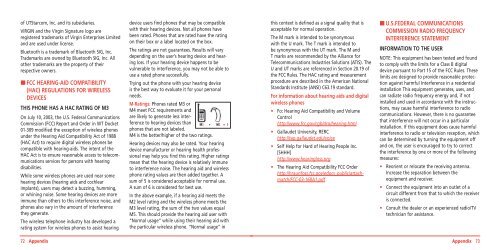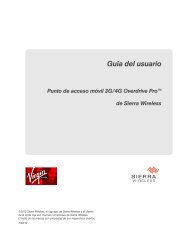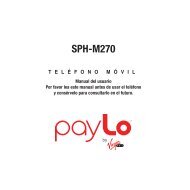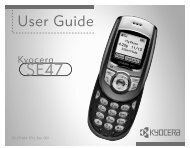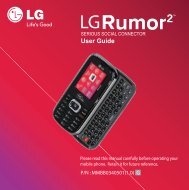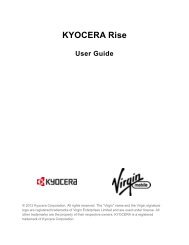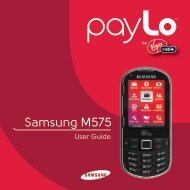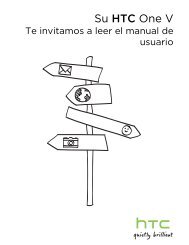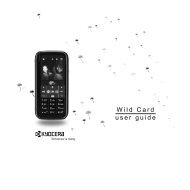Manual - Virgin Mobile
Manual - Virgin Mobile
Manual - Virgin Mobile
Create successful ePaper yourself
Turn your PDF publications into a flip-book with our unique Google optimized e-Paper software.
of UTStarcom, Inc. and its subsidiaries.<br />
VIRGIN and the <strong>Virgin</strong> Signature logo are<br />
registered trademarks of <strong>Virgin</strong> Enterprises Limited<br />
and are used under license.<br />
Bluetooth is a trademark of Bluetooth SIG, Inc.<br />
Trademarks are owned by Bluetooth SIG, Inc. All<br />
other trademarks are the property of their<br />
respective owners.<br />
H FCC HEARING-AID COMPATIBILITY<br />
(HAC) REGULATIONS FOR WIRELESS<br />
DEVICES<br />
THIS PHONE HAS A HAC RATING OF M3<br />
On July 10, 2003, the U.S. Federal Communications<br />
Commission (FCC) Report and Order in WT Docket<br />
01-309 modified the exception of wireless phones<br />
under the Hearing Aid Compatibility Act of 1988<br />
(HAC Act) to require digital wireless phones be<br />
compatible with hearing-aids. The intent of the<br />
HAC Act is to ensure reasonable access to telecommunications<br />
services for persons with hearing<br />
disabilities.<br />
While some wireless phones are used near some<br />
hearing devices (hearing aids and cochlear<br />
implants), users may detect a buzzing, humming,<br />
or whining noise. Some hearing devices are more<br />
immune than others to this interference noise, and<br />
phones also vary in the amount of interference<br />
they generate.<br />
The wireless telephone industry has developed a<br />
rating system for wireless phones to assist hearing<br />
device users find phones that may be compatible<br />
with their hearing devices. Not all phones have<br />
been rated. Phones that are rated have the rating<br />
on their box or a label located on the box.<br />
The ratings are not guarantees. Results will vary<br />
depending on the user’s hearing device and hearing<br />
loss. If your hearing device happens to be<br />
vulnerable to interference, you may not be able to<br />
use a rated phone successfully.<br />
Trying out the phone with your hearing device<br />
is the best way to evaluate it for your personal<br />
needs.<br />
M-Ratings: Phones rated M3 or<br />
M4 meet FCC requirements and<br />
are likely to generate less interference<br />
to hearing devices than M3 M2 5<br />
phones that are not labeled.<br />
M4 is the better/higher of the two ratings.<br />
Hearing devices may also be rated. Your hearing<br />
device manufacturer or hearing health professional<br />
may help you find this rating. Higher ratings<br />
mean that the hearing device is relatively immune<br />
to interference noise. The hearing aid and wireless<br />
phone rating values are then added together. A<br />
sum of 5 is considered acceptable for normal use.<br />
A sum of 6 is considered for best use.<br />
In the above example, if a hearing aid meets the<br />
M2 level rating and the wireless phone meets the<br />
M3 level rating, the sum of the two values equal<br />
M5. This should provide the hearing aid user with<br />
“Normal usage” while using their hearing aid with<br />
the particular wireless phone. “Normal usage” in<br />
this context is defined as a signal quality that is<br />
acceptable for normal operation.<br />
The M mark is intended to be synonymous<br />
with the U mark. The T mark is intended to<br />
be synonymous with the UT mark. The M and<br />
T marks are recommended by the Alliance for<br />
Telecommunications Industries Solutions (ATIS). The<br />
U and UT marks are referenced in Section 20.19 of<br />
the FCC Rules. The HAC rating and measurement<br />
procedure are described in the American National<br />
Standards Institute (ANSI) C63.19 standard.<br />
For information about hearing aids and digital<br />
wireless phones<br />
• Fcc Hearing Aid Compatibility and Volume<br />
Control<br />
http://www.fcc.gov/cgb/dro/hearing.html<br />
• Gallaudet University, RERC<br />
http://tap.gallaudet.edu/voice<br />
• Self Help for Hard of Hearing People Inc.<br />
[SHHH]<br />
http://www.hearingloss.org<br />
• The Hearing Aid Compatibility FCC Order<br />
http://hraunfoss.fcc.gov/edocs_public/attachmatch/FCC‐03‐168A1.pdf<br />
H U.S.FEDERAL COMMUNICATIONS<br />
COMMISSION RADIO FREQUENCY<br />
INTERFERENCE STATEMENT<br />
INFORMATION TO THE USER<br />
NOTE: This equipment has been tested and found<br />
to comply with the limits for a Class B digital<br />
device pursuant to Part 15 of the FCC Rules. These<br />
limits are designed to provide reasonable protection<br />
against harmful Interference in a residential<br />
installation This equipment generates, uses, and<br />
can radiate radio frequency energy and, if not<br />
installed and used in accordance with the instructions,<br />
may cause harmful interference to radio<br />
communications. However, there is no guarantee<br />
that interference will not occur in a particular<br />
installation. If this equipment does cause harmful<br />
interference to radio or television reception, which<br />
can be determined by turning the equipment off<br />
and on, the user is encouraged to try to correct<br />
the interference by one or more of the following<br />
measures:<br />
• Reorient or relocate the receiving antenna.<br />
Increase the separation between the<br />
equipment and receiver.<br />
• Connect the equipment into an outlet of a<br />
circuit different from that to which the receiver<br />
is connected.<br />
• Consult the dealer or an experienced radio/TV<br />
technician for assistance.<br />
72 Appendix<br />
Appendix 73


